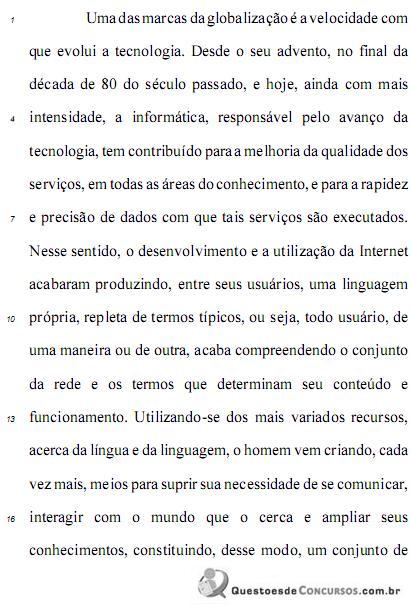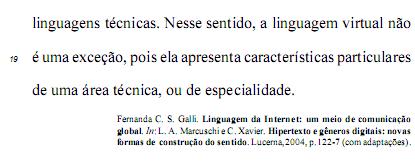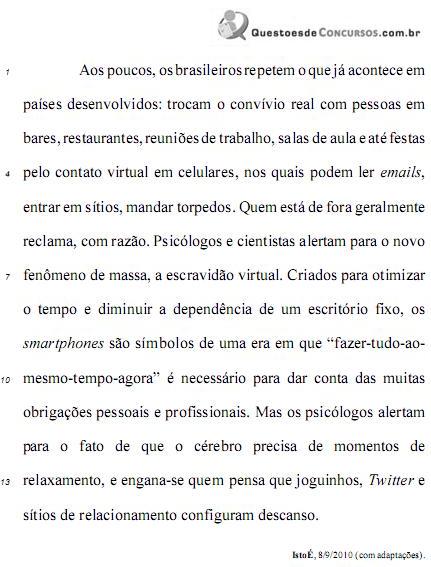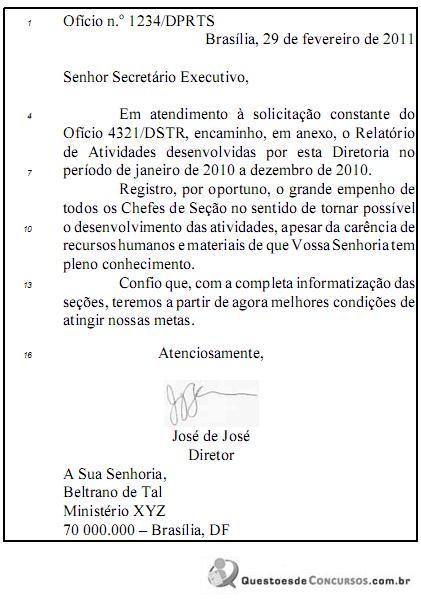Questões de Concurso Público INMETRO 2010 para Analista Executivo em Metrologia e Qualidade - Avaliação da Conformidade
Foram encontradas 70 questões

Seriam mantidas a correção gramatical do texto acima e a coerência entre seus argumentos caso se


Nas relações de coesão do texto, a expressão

Na organização das ideias no texto acima,

Para que o exemplo fictício de documento apresentado acima respeite as normas de elaboração de documentos oficiais, é necessário
In today’s society, measurements are used for many applications not only in industry and science but also in our daily life. There are measurements involved such as when buying petrol or foodstuff from the shop or energy from utilities; when trying to keep within the speed limits when driving your car; in health analyses when doctors diagnose and treat on the basis of blood pressure measurements; or when authorities make measurements to control the pollution in the air that we all breathe. Common to all these situations is that the measurement results need to be accepted (with confidence) by society. If not, the result is repeated measurements, disputes and legal actions. In most cases, the consumer or even the user of the measuring instrument does not personally have either the knowledge, the opportunity or the equipment to check whether the measurement that is so important for us is correct or not. In most countries, the legislature therefore has decided to set accuracy requirements for these types of measurements; most commonly, measurements in trade are regulated, but increasingly, also those within the health and environmental sectors.
Ongoing harmonization in Europe has become more and more the first reference point for authorities in the establishment of requirements for measurements, as requirements for new
measuring instruments are stated in directives; the most important of these directives being the Measuring Instrument Directive (MID) and the directive on Non-Automatic Weighing Instruments
(NAWI). For many of the instrument categories covered by the directives, there is a national possibility to select the prescription of different accuracy classes for different applications, and furthermore, to decide on what maximum permissible errors (MPEs) to apply in-service.

In today’s society, measurements are used for many applications not only in industry and science but also in our daily life. There are measurements involved such as when buying petrol or foodstuff from the shop or energy from utilities; when trying to keep within the speed limits when driving your car; in health analyses when doctors diagnose and treat on the basis of blood pressure measurements; or when authorities make measurements to control the pollution in the air that we all breathe. Common to all these situations is that the measurement results need to be accepted (with confidence) by society. If not, the result is repeated measurements, disputes and legal actions. In most cases, the consumer or even the user of the measuring instrument does not personally have either the knowledge, the opportunity or the equipment to check whether the measurement that is so important for us is correct or not. In most countries, the legislature therefore has decided to set accuracy requirements for these types of measurements; most commonly, measurements in trade are regulated, but increasingly, also those within the health and environmental sectors.
Ongoing harmonization in Europe has become more and more the first reference point for authorities in the establishment of requirements for measurements, as requirements for new
measuring instruments are stated in directives; the most important of these directives being the Measuring Instrument Directive (MID) and the directive on Non-Automatic Weighing Instruments
(NAWI). For many of the instrument categories covered by the directives, there is a national possibility to select the prescription of different accuracy classes for different applications, and furthermore, to decide on what maximum permissible errors (MPEs) to apply in-service.

In today’s society, measurements are used for many applications not only in industry and science but also in our daily life. There are measurements involved such as when buying petrol or foodstuff from the shop or energy from utilities; when trying to keep within the speed limits when driving your car; in health analyses when doctors diagnose and treat on the basis of blood pressure measurements; or when authorities make measurements to control the pollution in the air that we all breathe. Common to all these situations is that the measurement results need to be accepted (with confidence) by society. If not, the result is repeated measurements, disputes and legal actions. In most cases, the consumer or even the user of the measuring instrument does not personally have either the knowledge, the opportunity or the equipment to check whether the measurement that is so important for us is correct or not. In most countries, the legislature therefore has decided to set accuracy requirements for these types of measurements; most commonly, measurements in trade are regulated, but increasingly, also those within the health and environmental sectors.
Ongoing harmonization in Europe has become more and more the first reference point for authorities in the establishment of requirements for measurements, as requirements for new
measuring instruments are stated in directives; the most important of these directives being the Measuring Instrument Directive (MID) and the directive on Non-Automatic Weighing Instruments
(NAWI). For many of the instrument categories covered by the directives, there is a national possibility to select the prescription of different accuracy classes for different applications, and furthermore, to decide on what maximum permissible errors (MPEs) to apply in-service.

In today’s society, measurements are used for many applications not only in industry and science but also in our daily life. There are measurements involved such as when buying petrol or foodstuff from the shop or energy from utilities; when trying to keep within the speed limits when driving your car; in health analyses when doctors diagnose and treat on the basis of blood pressure measurements; or when authorities make measurements to control the pollution in the air that we all breathe. Common to all these situations is that the measurement results need to be accepted (with confidence) by society. If not, the result is repeated measurements, disputes and legal actions. In most cases, the consumer or even the user of the measuring instrument does not personally have either the knowledge, the opportunity or the equipment to check whether the measurement that is so important for us is correct or not. In most countries, the legislature therefore has decided to set accuracy requirements for these types of measurements; most commonly, measurements in trade are regulated, but increasingly, also those within the health and environmental sectors.
Ongoing harmonization in Europe has become more and more the first reference point for authorities in the establishment of requirements for measurements, as requirements for new
measuring instruments are stated in directives; the most important of these directives being the Measuring Instrument Directive (MID) and the directive on Non-Automatic Weighing Instruments
(NAWI). For many of the instrument categories covered by the directives, there is a national possibility to select the prescription of different accuracy classes for different applications, and furthermore, to decide on what maximum permissible errors (MPEs) to apply in-service.







